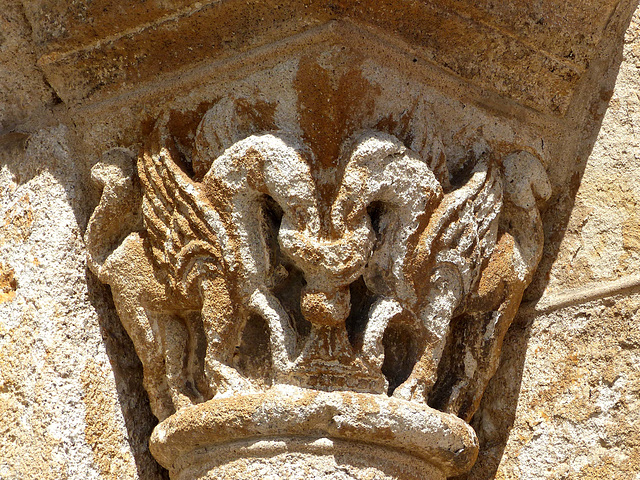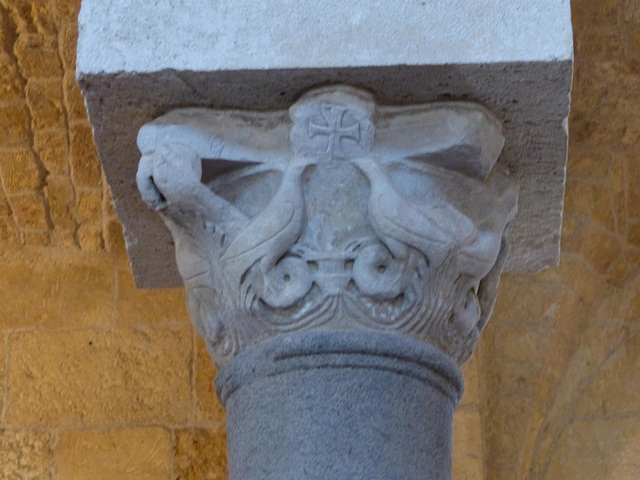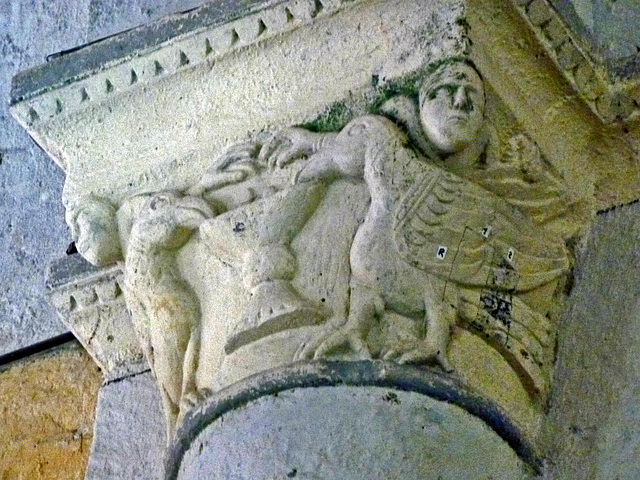
Birds drinking from a chalice
Birds or griffins (or even deers!) drinking from a chalice, cup or foutain is a symbol, that existed already in pre-Christian time.
Milan - Basilica of Sant'Ambrogio
Milan is the city capital of the Lombardy and the second most populous city in Italy after Rome. Known during Roman times as "Mediolanum" it was the place, where in 313 Constantine I and Licinius met and "signed" the "Edict of Milan", giving Christianity a legal status within the Roman empire.
At the end of the Roman empire Milan was besieged by the Visigoths in 402, looted by the Huns in 452, and taken by the Ostrogoths in 539. Only 30 years later is belonged to the Kingdom of the Lombards, until in 774 Charlemagne defeated the Langobards and added Milan to the Carolingian empire. During Barbarossa´s (Frederik I) "Italian Campaigns" Milan was taken and destroyed to a great extent.
The "Basilica of Sant'Ambrogio" is much older and was not destroyed by Barbarossa´s troops. It is one of the most ancient churches in Milan, built by St. Ambrose in 379–386, outside the city of Milan on the site of a cemetery, where the martyrs of the Roman persecutions had been buried. The first name of the church was "Basilica Martyrum".
Ambrose, born into a noble family about 340 in (present-day) Trier (Germany), was governor of Liguria and Emilia for two years before he became the Bishop of Milan in 374 by popular acclamation. He was a staunch opponent of Arianism.
Only very few traces of the first church can still be found, as in the centuries after its construction, the basilica underwent numerous restorations and reconstructions. The current Romanesque church, mostly built in brickwork, was begun around 1080.
In 789, a Benedictine monastery was established here. The canons of the basilica, however, retained their own community. So two separate communities shared the basilica. In the 11th century, the canons adopted orders and became Canons Regular. From then on two separate monastic orders following different rules lived in the basilica. The canons were in the northern building, the cloister of the canons, while the monks were in the two southern buildings.
The two towers symbolize the division in the basilica. The 9th century Torre dei Monaci ("Tower of the Monks") tower was used by the monks. However, the canons did not have a bell tower and were not allowed to ring bells until they finished the Canons' bell tower in the 12th Century. This tower got two additional levels in 1889.
In 1943 the basilica got severely damaged by bombings. It took a decade to rebuilt and reconstruct the church.
In front of the basilica is the atrium, where originally the catechumens gathered during the mass. As they were not yet baptized, they were not allowed to enter the basilica. When they were waiting here, they could contemplate about the evil monsters and strange animals, that populate the capitals and lintels all around.
"Two birds drinking from a chalice" is and ancient icon, that in Christianity developed into an Eucharistic symbol, associated with Baptism and Resurrection.
Souvigny - Prieuré Saint-Pierre-et-Saint-Paul
In 915 Aymar de Bourbon, ancestor of the House of Bourbon, gave land in Souvigny to the Cluny Abbey for the construction of a monastery. At that time the "Abbaye de Cluny" was just 5 years old, as it had been founded 910 by William I, Duke of Aquitaine, (aka "William the Pious").
Souvigny was one of the first priories, dependent from the Cluny Abbey, so it was known later as "one of the five eldest daughters of Cluny".
Cluny developed into the most powerful abbey in the Middle Ages, when the Cluniac Reforms changed the monastic life in Europe. German historian Dr. Joachim Wollasch ("Cluny, Licht der Welt"), estimates that in its haydays, more than 10.000 monks were parts of this network´, that stretched all over Europe. The pelerinage to Santiago de Compostella was one of the great "themes", developed and strongly supported by Cluny.
The priory in Souvigny, located about 130kms west of Cluny, was such an important convent, that two of the powerful abbots of Cluny, Majolus (+ 994) and Odilo (+ 1049) died here. Their graves were a place of pilgrimage site soon after. To cope with the growing number of pilgrims, the priory´s church got enlarged already within the 10th century.
Mayeul (= Majolus) was the 4th, Odilon (= Odilo) was the 5th abbot of the Abbey of Cluny. Odilo "invented" and established the "All Souls' Day" (2. November), that was adopted in the whole Western church.
The church, probably built after the model of Cluny III, with five aisles structure and two transepts, crumbled, when the times got tougher in the next centuries. A renovation was done in the 15th century, but the interior structure is still "clearly" Romanesque. It got recently renovated.
In 1793 French revolutionaries raged here with furor, destroyed the tombs and beheaded the sculptures, they believed to be connected to the Pope, Abbots or Bourbons.
They did not touch (most of) the capitals.
Two griffins, drinking from a chalice.
The icon two birds or griffins drinking from a chalice (or fountain / "fons vitae") has roots into Greek and Roman iconopgraphy. In Christianity it developed into an Eucharistic symbol, associated with baptism and resurrection.
Autry-Issards - Sainte-Trinité
Sainte-Trinité dates back to the early 12th century. It is Romanesque, described as "style bourguignon". The dedication to the Holy Trinity is not very frequent in this period. Autry was part of the convent Montet-aux-Moines (20kms south), itself a priory dependent on Saint-Michel-de-la-Cluse in Piedmont ("Sacra di San Michele" near Turino, Italy).
Later the parish passed under the authority of the Abbess of Saint-Menoux, just a few kilometers north.
The portal of Sainte-Trinité is impressive (previous uploads). This capital depicting two birds/griffins drinking from a chalice, a very common icon in medieval times, is on its left side.
Porto Torres - San Gavino
The Roman colony of "Turris Libisonis" existed already in the first century, where now is the town of Porto Torres. This even was a bishopric seat from 489 until 1441, when the see was moved to Sassari.
Two older basilicas, dating to the 5th – 7th centuries, built over the tomb of Saint Gabinus, a local martyr, existed - and got replaced by this large building in the 11th century.
The church was built by Pisan masters and got consecrated in 1080. With a lengths of 55 metres this is the largest Romanesque church on the island.
The interior is sober. The columns, that line the nave, were taken from ancient buildings. Some of the capitals may be Roman, this one is Christian. The "Birds drinking from a chalice"- icon.
Mozac - Saint-Pierre et Saint-Caprais
Mozac Abbey is one of the oldest monasteries in the Auvergne, dating back into Merovingian times. A legend tells that it was founded by Calminius (later Saint Calmin). He must have been pretty important and well off, as his name is connected to the foundations of three abbeys. He introduced the benedictian rules to the area, and brought (from Rome)a relic of Saint Peter and (from Agen) a relic of Saint Caprasius to Mozac. He got buried in the crypt of this church together with his wife Saint Namadie. Within the 9th century relics of Saint Austremonius, the first bishop of Clermont were transferred to Mozac, so already before Santiago de Compostella was on the map, this was a place of pilgrimage.
In 1095 Mozac abbey got affiliated to Cluny, but was important enough, to have Hugue of Semur, nephew of Hugue of Cluny here as abbot. He was followed by Eustachius, brother of Petrus Venerabilis.
Three churches could be traced here by archeologists, what can be seen today is "Mozac 3", a great church built within the first half of the 12th century.
As most of "Mozac 3" got destroyed by a number earthquakes between 1437 and 1490. Actually only ruins can be seen. Apses, choir, ambulatory, radial chapels, transept and clerestorys were beyond repair, when the early reconstruction started - in gothic style.
Most pillars and capitals of "Mozac 3" are still in place (in situ).
Some / Most of the carvings here are so "perfect", that they seem to be much younger, even baroque, but all are - 12th century - romanesque.
-
Two fantastic griffons, with a grim expression, around a chalice. Absolutely symmetrical. To place two mythical animals or birds aside a chalice is a common theme in the Auvergne, but these griffons here are very spectacular chimeras. Note the tail that splits into two and then transforms to foliage. Crossing the border between fauna and flora
Saint-Hilaire-la-Croix
What is the parish church of the tiny village of Saint-Hilaire-la-Croix today, was the church of a priory, depending from Mozat around 1165.
In the beginning the priory was named "Saint-Hilaire-lac-rouge", but over the time, the old name got a little "deformed". There is not much known about the priory. In the early years it served the pilgrims on their way - and somehow it was important enough, to built (and finance) such an extraordenary church. Bernard Craplet ("Auvergne romane") dates the building phase from around 1100 to 1200. Later Augustinian Canons and Vincentians lived here. Not a sucess story for the next centuries the buildings were sold already in 1742.
One of capitals at the crossing depicts the two birds and between them the chalice. One of the symmetrical "icons", that can often be seen in the Auvergne. Special here are the two men behind the birds. With stoic faces they are putting /dropping something into the calice. Small round objects. Hosts? How did the sacramental bread look like in the 12th century?
Restoration seems to be on its way here. Two zones have been obviously treated by a chemical (antifungal?) substance. Now the effect is watched. That explains the little stickers.
Melle - Saint-Hilaire
Silver and lead were mined in Melle since Roman times. In Merovingian and Carolingian times it was a home of a mint. In 2008 archaeologists found a silver penny under the floor of the Palatine Chapel in Aachen (Aix La Chapelle). It was minted at METVLLO what is Melle today.
In medieval times Melle was a prosperous town, attracting many pilgrims following the Via Turonensis. The town (today´s pop. ~4000) still hosts three Romanesque churches, built during the 11th and 12th centuries.
Saint-Hilaire de Melle was the church of a priory, a dependency of the important Benedictine abbey in Saint-Jean-d’Angély. It was built on the bank of the Beronne river. The eastern part were built in the first half of the 12th century, while the nave and the western portals may be some decades younger.
Two winged creatures drinking from a chalice.
-
As I have uploaded many photos from here already, I will just add a few.
Conques - Sainte-Foy
Conques is a popular stop for all pilgrims traveling the Via Podiensis. This is a treat after having crossed the harsh Aubrac. I had started in Geneva in 2008 and I still remember my feelings, when I reached Conques after some weeks.
A tiny convent existed here already in the 8th century. This grew into a very successful monastery, after the relics of St. Foy arrived in Conques through theft in 866. The relics were stolen by a monk from Conques, who had posed as a loyal monk in Agen for years.
The arrival of the relics of St. Foy caused the pilgrimage route to shift to Conques. As the existing church was too small for all the pilgrims, a new, much larger church had to be constructed. It was completed by the end of the 11th century. As a large pilgrim´s church it had an ambulatory with five radiating chapels. A century later galleries were added over the aisle and the roof was raised over the transept and choir to allow people to circulate at the gallery level. This can still be done for an hour in the evening and is - absolutely breathtaking!
Different masons and carvers have worked in Conques over the building process, so here are different Romanesque styles. The oldest capitals are around the choir´s ambulatory.
Two birds drinking from a chalice ("fons vitae"), an Eucharistic symbol.
Saint-Savin - Saint-Savin
It is unknown when this important abbey was founded here. Legends tell, that Charlemagne was involved as well as his son Louis the Pious and Benedict of Aniane.
The church was erected from about 1050 on. As in the crypt of the large church the relics of St. Savin and St. Cyprian were displayed, a large ambulatory with five radial chapels was added for the many pilgrims. The church burnt down during the Hundred Years' War, but got rebuilt and reconstructed in the 17th and 19th century.
As many medieval frescoes and murals have survived here since 1983 the "Abbey Church of Saint-Savin-sur-Gartempe" has been a UNESCO World Heritage Site. There are about 400m² of frescoes, indeed something like a "picture book". André Malraux hailed this as "the Sistine Chapel of the Romanesque period".
The few carvings I saw inside the crypt under the choir are probably some decades older than the capitals of the nave. They are of course smaller and the carving style is less sophisticated.
Jump to top
RSS feed- Latest items - Subscribe to the latest items added to this album
- ipernity © 2007-2024
- Help & Contact
|
Club news
|
About ipernity
|
History |
ipernity Club & Prices |
Guide of good conduct
Donate | Group guidelines | Privacy policy | Terms of use | Statutes | In memoria -
Facebook
Twitter










